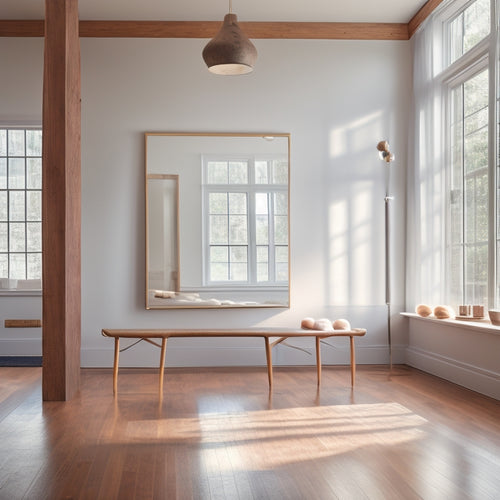
How Do I Practice Ballet at Home?
Share
To practice ballet at home, you'll need a dedicated space with a smooth floor, minimal furniture, and proper lighting. Invest in a sturdy barre and a mirror for real-time correction. Warm up with targeted stretching exercises and focus on mastering basic ballet positions, such as heel-toe alignment and proper arm placement. Practice barre work in a distraction-free space, and develop a daily routine that incorporates turns, jumps, flexibility, and strength exercises. As you progress, refine your technique, and explore ways to overcome common challenges, you'll discover a world of possibilities in your ballet journey.
Key Takeaways
• Designate a quiet, clutter-free space with a smooth floor, ideal for wood or Marley flooring, to practice ballet at home.
• Invest in essential equipment like a sturdy, adjustable barre, a sprung or Marley floor, and a mirror for posture correction.
• Warm up with targeted stretching exercises, dynamic stretching, and muscle activation exercises to prevent injuries and improve technique.
• Focus on mastering basic ballet positions, including heel-toe alignment, proper arm placement, and turnout and rotation techniques.
• Establish a daily practice routine, including slow, controlled movements at the barre, turns, jumps, flexibility, and strength training exercises to see consistent improvement.
Setting Up Your Home Studio
To create an effective home studio, start by designating a quiet, clutter-free area with a smooth floor, ideally made of wood or Marley, that provides sufficient space for you to move freely in all directions. This dedicated space will become your sanctuary for ballet practice.
Consider the Home Decor elements that promote focus and calmness, such as a minimalist color palette and minimal furniture.
Proper Studio Lighting is also essential, as it enhances your visibility and allows you to correct your posture and alignment. Aim for soft, natural light or invest in high-quality LED lights that mimic daylight.
Essential Equipment for Beginners
As you set up your home ballet studio, you'll need to gather essential equipment to guarantee a safe and effective practice.
You'll want to prioritize three key components: a sturdy barre, a suitable flooring surface, and a well-placed mirror.
Barre Essentials
What essential equipment do you need to get started with barre practice at home, and how do you choose the right one for your ballet journey?
As a beginner, investing in a high-quality barre is essential. Look for a sturdy, adjustable barre that can support your weight. Consider a wall-mounted or freestanding barre that allows for flexibility in your practice.
Understanding barre etiquette is important; respecting the barre and your body is key to a safe and effective practice.
Explore barre history to appreciate its evolution and significance in ballet training. With the right equipment and knowledge, you'll be well on your way to a successful home practice.
Proper Flooring Matters
You'll need a floor that can absorb shock and provide traction to prevent slipping, especially when you're executing turns or jumps, which makes a sprung floor or a marley floor an ideal choice for your home ballet practice. These floors are designed to reduce the impact on your joints, minimizing the risk of dance injuries.
Proper floor maintenance is important to guarantee your floor remains safe and effective. Regularly sweep or vacuum your floor to prevent dirt and debris from accumulating, and mop it with a gentle cleaner to keep it clean.
Mirror Image Needed
With a safe and suitable floor in place, set up a mirror that provides an unobstructed view of your entire body, allowing you to correct your posture, alignment, and movements in real-time. This mirror image is essential for ballet practice, as it enables you to monitor your technique and make adjustments instantly.
A mirrorless alternative is a virtual reflection, which can be achieved through video recording or live streaming. However, a physical mirror remains the most effective tool for immediate feedback. Don't compromise on the quality of your practice – invest in a good mirror that provides an accurate reflection.
Warming up With Stretching Exercises
As you prepare to begin your ballet practice, dedicating a few minutes to targeted stretching exercises will help increase flexibility and reduce the risk of injury.
Dynamic stretching is an essential component of your warm-up, as it prepares your muscles for movement. Start with leg swings, arm circles, and torso twists to activate your muscles and increase blood flow.
Next, focus on specific muscle activation exercises, such as calf raises and ankle rotations, to target key areas used in ballet. By incorporating these exercises into your warm-up routine, you'll improve your range of motion and set yourself up for a successful practice.
Remember to hold each stretch for 15-30 seconds and breathe naturally, feeling the stretch in your muscles.
Mastering Basic Ballet Positions
As you begin mastering basic ballet positions, you'll focus on three essential elements: heel-toe alignment, proper arm placement, and turnout and rotation.
You'll need to guarantee your heels are aligned with your toes, your arms are positioned correctly, and your turnout and rotation are executed correctly.
Heel-Toe Alignment
You must align your heels and toes in a straight line, with your weight evenly distributed between both feet, to achieve proper heel-toe alignment in basic ballet positions. This fundamental aspect of ballet technique is essential for maintaining balance, stability, and overall posture.
To master heel-toe alignment, focus on the following key elements:
-
Proper Posture: Engage your core, lengthen your spine, and avoid slouching or leaning forward.
-
Ankle Mobility: Confirm your ankles are flexible and able to rotate freely, allowing your heels and toes to align properly.
-
Weight Distribution: Evenly distribute your weight between both feet, avoiding putting too much pressure on one foot or the other.
- Body Awareness: Develop awareness of your body position and alignment, making adjustments as needed to maintain proper heel-toe alignment.
Proper Arm Placement
With heel-toe alignment established, you're now ready to focus on proper arm placement, a fundamental aspect of mastering basic ballet positions that requires coordinated movement and control.
As you stand or move, maintain relaxed shoulders, avoiding tension that can restrict your range of motion. Imagine a gentle, downward pull, keeping your shoulders soft and open. Your arms should frame your movement, not dominate it.
Keep your elbows slightly bent, with a subtle curve to your arms. This will help you maintain a sense of fluidity and control.
As you practice, focus on smooth, coordinated shifts between movements, using your arms to enhance and support your overall movement quality.
Turnout and Rotation
Mastering turnout and rotation is vital for achieving proper ballet alignment, as it enables you to rotate your legs and hips while maintaining a stable core and controlled movements. This fundamental concept is essential for executing various ballet techniques, including pirouettes, fouettés, and grand jetés.
To improve your turnout and rotation, focus on:
-
Hip Alignment: Make sure your hips are parallel to each other and aligned with your shoulders.
-
Rotational Strength: Engage your core muscles to generate power and control.
-
Leg Rotation: Practice rotating your legs in both directions, focusing on smooth, controlled movements.
- Core Engagement: Activate your core muscles to maintain stability and balance.
Practicing Barre Work at Home
Proper alignment and deliberate movement are essential when practicing barre work at home, where mirrors and instructors aren't always present to correct your form. You'll need to develop self-awareness of your body positioning and movement quality.
Establish a quiet, distraction-free space that allows you to focus on your technique. Minimize home distractions by turning off electronic devices and finding a quiet corner. Observe basic barre etiquette by standing with your feet parallel to each other, engaging your core, and keeping your shoulders relaxed.
Practice slow, controlled movements, maintaining proper alignment throughout the exercise. By doing so, you'll build strength, flexibility, and control, even without the guidance of an instructor.
Center Exercises for Balance
You'll now move on to center exercises that target balance, where you'll engage your core and challenge your stability, further developing the strength and control you've built through barre work. This is where you'll refine your body awareness, focusing on the subtle adjustments that maintain balance.
To improve your balance, try these exercises:
-
Single-leg balances: Stand on one leg, with the other foot resting on the inner thigh. Hold for 30 seconds, then switch legs.
-
Heel-toe walks: Walk along a straight line, placing the heel of one foot directly in front of the toes of the other foot.
-
Pirouette prep: Stand in a turned-out position, then lift one foot off the ground, keeping it turned out. Hold for a few seconds, then lower.
- Core strengthening poses: Engage your core by drawing your belly button towards your spine, maintaining a long, straight line from head to heels.
Remember to focus on controlled movements and precise alignment to improve your core strength and balance.
Working on Turns and Jumps
As you progress to more dynamic movements, focus on developing your turning and jumping techniques by practicing exercises that build explosive power, control, and coordination.
To improve your pirouette technique, practice slow, controlled turns in both directions, focusing on maintaining a steady center and smooth shifts. Gradually increase your speed and number of turns as you build confidence.
For jumping variations, try petit allegro exercises like temps liés and glissés to develop quick footwork and explosive power. Practice jumping in different directions and heights to challenge your coordination and control.
Remember to always warm up thoroughly and listen to your body to avoid injury. With consistent practice, you'll be turning and jumping like a pro in no time!
Improving Flexibility and Strength
To complement your growing proficiency in turns and jumps, focus on developing the flexibility and strength required to maintain proper alignment and control throughout complex movements.
Incorporate exercises that target specific muscle groups, such as:
-
Leg swings: Use resistance bands to strengthen your legs and improve flexibility.
-
Foam rolling: Release tension in your muscles, particularly in your IT band and quadriceps.
-
Core engagement: Engage your core to maintain proper posture and control.
- Pliés and tendus: Practice these fundamental movements to build strength and control in your legs.
Creating a Daily Practice Routine
Establish a consistent daily practice routine to reinforce new skills and solidify muscle memory, allocating specific times for technique work, stretching, and review of previous lessons. This daily discipline will help you stay focused and committed to your ballet goals.
Set specific, achievable goals for yourself, and break them down into smaller, manageable tasks to guarantee progress.
| Time of Day | Activity | Duration |
| Morning | Technique work | 30 minutes |
| Afternoon | Stretching | 20 minutes |
| Evening | Review of previous lessons | 30 minutes |
Overcoming Common Challenges
As you begin your ballet practice at home, you'll likely encounter two major hurdles: limited space constraints and lack of guidance.
You'll need to adapt your movements to fit your available space, which can be frustrating when you're used to a studio setting.
Limited Space Constraints
When dancing in cramped quarters, you'll quickly realize that a traditional ballet studio's expansive floor space is a luxury you can't afford, forcing you to adapt your practice to the confines of your home.
As a Space Saver, you'll need to get creative with your furniture arrangement to maximize your practice space. Here are a few tips to help you overcome limited space constraints:
-
Rearrange your furniture to create a clear path for movement.
-
Use mirrors strategically to create the illusion of more space.
-
Invest in a portable ballet barre that can be easily set up and taken down.
- Focus on exercises that don't require a lot of space, such as footwork, alignment, and core strengthening exercises.
Lack of Guidance
Without personalized feedback and correction, you'll struggle to identify and correct flaws in your technique, making it essential to develop strategies for self-assessment and improvement. To overcome the lack of guidance, consider the following options:
| Resource | Description | Benefits |
|---|---|---|
| Online tutorials | Video classes with experienced instructors | Access to expert guidance, flexibility in scheduling |
| Personal instructors | Private lessons with a ballet teacher | Tailored feedback, correction, and improvement |
| Virtual mentors | Online coaching with experienced dancers | Personalized guidance, accountability, and motivation |
| Dance communities | Online forums, social media groups, or local dance studios | Connection with fellow dancers, feedback, and support |
Frequently Asked Questions
What if I Don't Have a Mirror at Home to Correct My Form?
"Lost in a forest of uncertainty, without a mirror to guide you? Record yourself dancing, then analyze the video to correct your form. Virtual feedback from online classes can also be your trusted compass, leading you to technical precision."
Can I Still Practice Ballet if I Have a Small Living Space?
You can still practice ballet in a small living space by incorporating space-saving modifications, such as using a wall for support or doing exercises in a chair, and creating creative arrangements to maximize your available space.
How Do I Stay Motivated to Practice Ballet at Home Regularly?
To stay motivated, you'll create a routine, setting specific goals and tracking progress; reward yourself for milestones achieved, and find accountability through online communities or a practice buddy to maintain your dedication.
What if I'm Not Flexible or Coordinated, Can I Still Practice Ballet?
Like a budding flower, you can unfold into a ballet dancer, regardless of flexibility or coordination. Focus on body awareness, mindful movement, and gentle modifications; core strengthening exercises will help you bloom into a confident practitioner.
Can I Practice Ballet at Home if I'm Overweight or Obese?
You can practice ballet at home regardless of your weight, embracing body positivity and reaping health benefits like increased flexibility, strength, and cardiovascular endurance, all while fostering a positive relationship with your body.
Related Posts
-

Market and Sell Digital Products as a Dance Artist
You're a dance artist with a wealth of knowledge and creativity, and now you want to turn that into digital products ...
-

What to Look for in a Home Professional Ballet Barre
When choosing a home professional ballet barre, look for durability and solid construction, which guarantees it stand...
-

Dynamic Dance Designs: Unleash Your Creativity
By tapping into the limitless potential of Dynamic Dance Designs' cutting files, you can break free from creative con...


